Earth’s population will hit EIGHT BILLION next week: Key milestone for humanity as life expectancy increases… with headcount already triple the 2.5 billion of 1950
- By 2030, the world’s population will reach 8.5 billion and by 2100, 10.4 billion
- Population growth was growing at its slowest pace since 1950, figures show
- A key factor driving global population growth is increased life expectancy
Published: | Updated:
The UN Population Division said that the population will continue to grow in the decades to come, with life expectancy set to increase to an average of 77.2 years by 2050.
By November 15, the number of humans on Earth will grow to eight billion, more than three times higher than the 2.5 billion global headcount in 1950.
The increase in life expectancy, as well as the number of people of childbearing age, has meant the UN predicts the world’s population will continue growing to about 8.5 billion in 2030, 9.7 billion in 2050, and a peak of about 10.4 billion in the 2080s.
But the population growth rate, after a peak in the early 1960s, has decelerated dramatically to below 1 per cent in 2020, Rachel Snow of the UN Population Fund said.
That figure could potentially fall to around 0.5 percent by 2050 due to a continued decline in fertility rates, the United Nations projects.
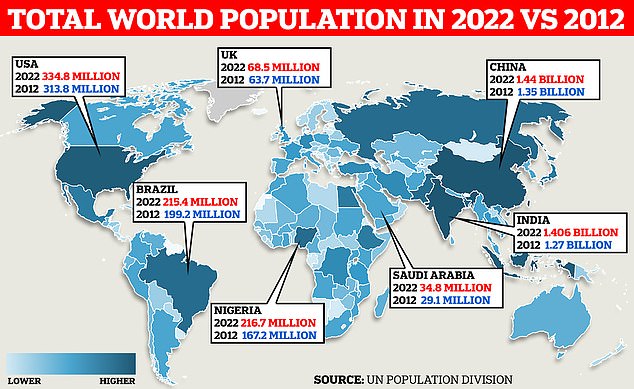
The world’s population is set to hit eight billion by November 15 this year, a United Nations report has revealed
In 2021, the average fertility rate was 2.3 children per woman over her lifetime, down from about five in 1950, according to the UN, which projects that number to fall to 2.1 by 2050.
‘We’ve reached a stage in the world where the majority of countries and the majority of people in this world are living in a country that is below replacement fertility,’ or roughly 2.1 children per woman, says Miss Snow.
A key factor driving global population growth is that average life expectancy continues to increase: 72.8 years in 2019, nine years more than in 1990. And the UN predicts an average life expectancy of 77.2 years by 2050.
The result, combined with the decline in fertility, is that the proportion of people over 65 is expected to rise from 10 per cent in 2022 to 16 percent in 2050.
This will have an impact on labour markets and national pension systems, while requiring much more elderly care.
Meanwhile, beneath the global averages are some major regional disparities.
For example, the UN projects that more than half of the population growth by 2050 will come from just eight countries: the Democratic Republic of Congo, Egypt, Ethiopia, India, Nigeria, Pakistan, the Philippines and Tanzania.
The average age in different regions is also meaningful, currently at 41.7 years in Europe versus 17.6 years in Sub-Saharan Africa, according to Miss Snow, who says the gap ‘has never been as large as it is today’.
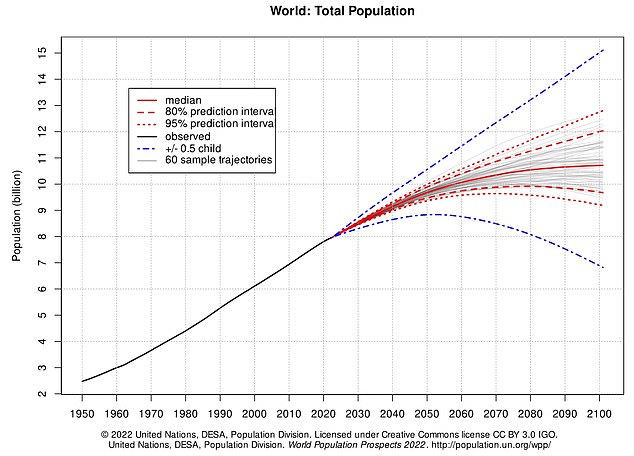
The study for World Population Day revealed that the pace of mortality slowing means the world’s population will reach eight billion in just over four months time, 8.5 billion by 2030 and 10.4 billion by 2100 (pictured, the world’s population growth over the years)
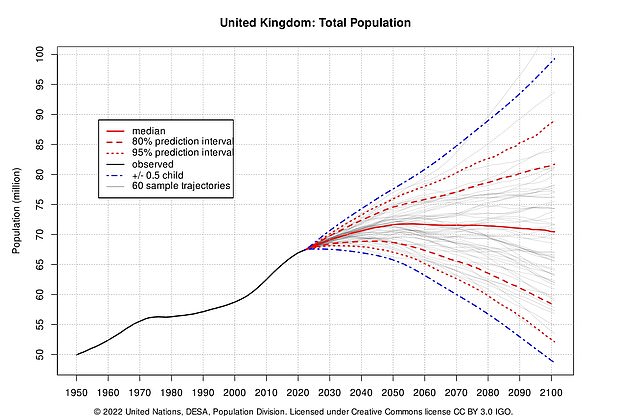
The UK has a current population of 68.5 million in 2022, with an average annual rate of population change of 0.4 per cent compared to India’s 0.9
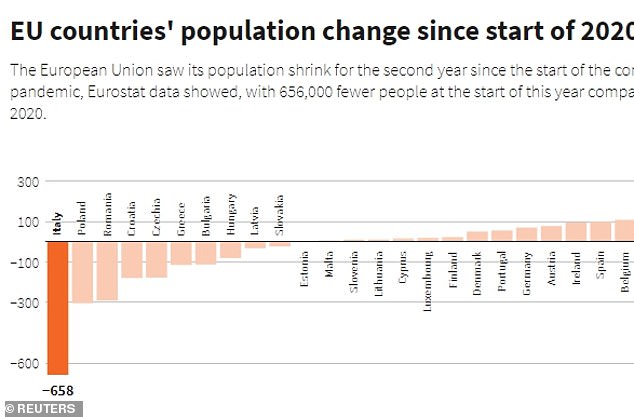
The European Union’s population shrank for a second year running last year, the bloc’s statistics office said on Monday
Those numbers could even out, but unlike in the past when countries’ average ages were mostly young, says Miss Snow, ‘in the future, we may be closer in age, mostly old’.
Some experts believe these regional demographic differences may play a significant role in geopolitics going forward.
In another illustration of changing trends, the two most populous countries, China and India, will trade places on the podium as early as 2023, according to the UN.
China’s 1.4 billion population will eventually begin to decline, falling to 1.3 billion by 2050, the UN projects.
By the end of the century, the Chinese population could fall to only 800 million.
India’s population, currently just below that of China, is expected to surpass its northern neighbor in 2023, and grow to 1.7 billion by 2050 – though its fertility rate has already fallen below replacement level.
The United States will remain the third most populous country in 2050, the UN projects, but it will be tied with Nigeria at 375 million.
United Nations Population Fund chief Natalia Kanem hailed the new figures as a ‘momentous milestone’ for humanity.
‘Eight billion people, it is a momentous milestone for humanity,’ Miss Kanem said, praising an increase in life expectancy and fewer maternal and child deaths.
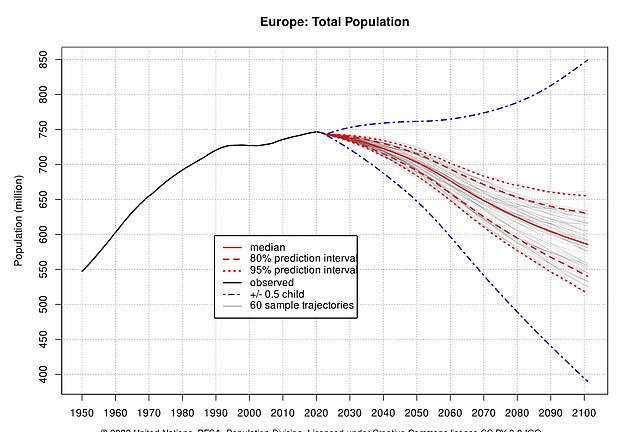
Population growth was growing at its slowest pace since 1950, having fallen below 1 per cent in 2020, UN estimates showed. Pictured, Europe’s population fall
‘Yet, I realize this moment might not be celebrated by all. Some express concerns that our world is overpopulated. I am here to say clearly that the sheer number of human lives is not a cause for fear,’ she added.
So, are there too many of us for Earth to sustain?
Many experts say that this is the wrong question. Instead of the fear of overpopulation, we should focus on the overconsumption of the planet’s resources by the wealthiest among us.
‘Too many for whom, too many for what? If you ask me, am I too many? I don’t think so,’ Joel Cohen of Rockefeller University’s Laboratory of Populations said.
He said the question of how many people Earth can support has two sides: natural limits and human choices.
Our choices result in humans consuming far more biological resources, such as forests and land, than the planet can regenerate each year.
The overconsumption of fossil fuels, for example, leads to more carbon dioxide emissions, responsible for global warming.
We would need the biocapacity of 1.75 Earths to sustainably meet the needs of the current population, according to the Global Footprint Network and WWF NGOs.
The most recent UN climate report mentions population growth as one of the main drivers of an increase in greenhouse gases. However, it plays a smaller role than economic growth.
‘We are stupid. We lacked foresight. We are greedy. We don’t use the information we have. That’s where the choices and the problems lie,’ said Mr Cohen.
However, he rejects the idea that humans are a curse on the planet, saying people should be given better choices.
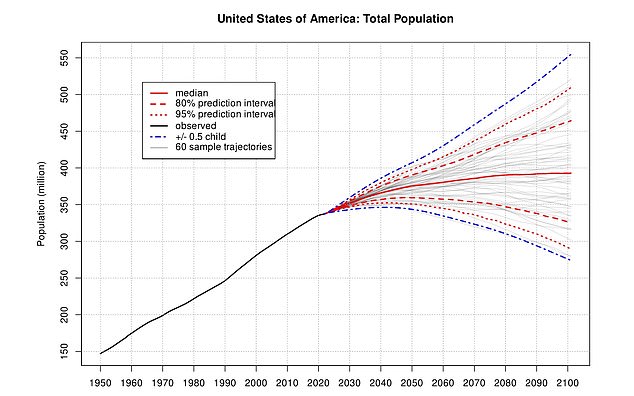
The population of 61 countries is projected to decrease by 1 per cent or more between 2022 and 2050, driven by a fall in fertility. Pictured, the US population growth
‘Our impact on the planet is driven far more by our behavior than by our numbers,’ said Jennifer Sciubba, a researcher at the Wilson Center think tank.
‘It’s lazy and damaging to keep going back to overpopulation,’ she added, as this allows people in wealthy nations, who consume the most, to cast the blame for the planet’s woes onto developing countries where population growth is highest.
‘Really, it’s us. It’s me and you, the air conditioning I enjoy, the pool I have outside, and the meat I eat at night that causes so much more damage.’
If everyone on the planet lived like a citizen of India, we would only need the capacity of 0.8 Earths a year, according to the Global Footprint Network and WWF. If we all consumed like a resident of the United States, we would need five Earths a year.
The United Nations estimates that our planet will be home to 9.7 billion people by 2050.
One of the trickiest questions that arise when discussing population is that of controlling fertility. Even those who believe we need to lower the Earth’s population are adamant about protecting women’s rights.
Robin Maynard, the executive director of the NGO Population Matters, says there needs to be a decrease in the population, but ‘only through positive, voluntary, rights-respecting means’ and not ‘deplorable examples’ of population control.
The NGO Project Drawdown lists education and family planning among the top 100 solutions to halt global warming.
‘A smaller population with sustainable levels of consumption would reduce demands on energy, transportation, materials, food and natural systems.’
Vanessa Perez of the World Resources Institute agrees that ‘every person that is born on the planet puts additional stress on the planet.’
‘It is a very thorny issue,’ she said, adding that we should reject ‘this idea that the elite capture this narrative and say we need to cap population growth in the South.’
She believes the most interesting debate is not about the number of people but ‘distribution and equity.’
Mr Cohen points out that even if we currently produce enough food for 8 billion people, there are still 800 million people who are ‘chronically undernourished.’
‘The concept of ‘too many’ avoids the much more difficult problem, which is: are we using what we know to make the human beings we have as healthy, productive, happy, peaceful, and prosperous as we could?’
European Union’s population shrinks for a second year running
The European Union’s population shrank for a second year running last year, the bloc’s statistics office said on Monday, as the region reels from over two million deaths from the coronavirus.
According to Eurostat, the population of the 27 countries that make up the bloc fell by close to 172,000 from the previous year and over 656,000 from January 2020.
‘In 2020 and 2021 the positive net migration no longer compensated for the negative natural change in the EU and, as a consequence, the EU total population has been decreasing,’ it said, pointing to impacts from the pandemic.
The number of deaths began outstripping births in the EU a decade ago, but immigration from outside the bloc helped offset the gap until the first year of the pandemic.
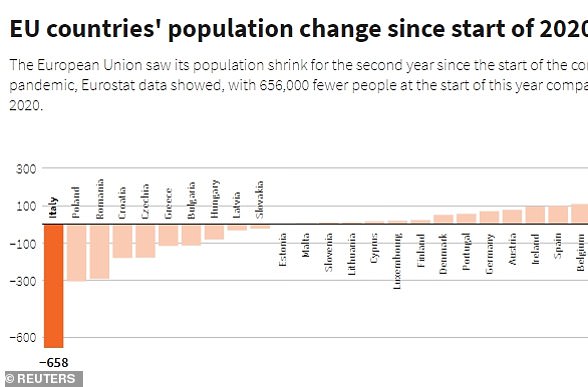
The European Union’s population shrank for a second year running last year, the bloc’s statistics office said on Monday
The previous time the EU had registered a fall in population was in 2011 – the only other time since 1960 – but this rapidly picked up due to net migration.
Eurostat said deaths should continue to outstrip births in the coming years given the pandemic, an aging population and relatively low fertility rates.
‘Should this be the case, the EU’s overall population decline or growth in the future is likely to depend largely on the contribution made by net migration,’ the report said.
More than half of EU member states saw their populations increase, with France leading, then Netherlands and Sweden.
Italy, Poland and Romania recorded the largest population falls in the EU.
Eurostat counted 446.8 million people living inside the EU by January 2022.
Share this news
This Year’s Most Read News Stories

Zanzibar airport operators decry job losses over Dubai deal
Tanzania air operators say over 600 workers are set to lose their jobs after the semi-autonomous government of Zanzibar awarded a Dubai-based company exclusive rights to handle ground services at a refurbished airport.
The Tanzania Air Operators Association (Taoa) said in a statement that the contract awarded to Dnata, which is registered at the London Stock Exchange, was in breach of the law banning any company from having exclusive rights to ground-handling services at major airports.Continue Reading

Inside Tanzania’s Life-Saving Birthcare Model

Tanzania is winning the battle against maternal and newborn deaths, as the latest numbers reveal a significant decline.
“Tanzania is committed to reducing maternal and newborn mortality and ensuring safe deliveries as part of the national development plan. The Safer Births Bundle of Care is one of the key strategies supporting this effort,” said Dr. Benjamin Kamala, the Senior Research Scientist at Haydom Lutheran Hospital and Principal Investigator for the program, leading its implementation across five regions in Tanzania.
A groundbreaking study published in the New England Journal of Medicine shows that the innovative health program in Tanzania – centered on regular, on-the-job training for healthcare workers – reduced maternal deaths by 75% and early newborn deaths by 40%. The three-year study, conducted across 30 high-burden healthcare facilities in Tanzania, tracked approximately 300,000 mother-baby pairs under the Safer Births Bundle of Care (SBBC) programme. The programme focuses on improving care for mothers and babies during the day of birth, the critical time when a woman goes into labor and delivers her baby.
Maternal health is a key focus of the United Nations Sustainable Development Goals (SDGs), specifically Target 3.1, which aims to reduce the global maternal mortality ratio to fewer than 70 deaths per 100,000 live births by 2030.
Tanzania’s program combines continuous, simulation-based training for frontline healthcare workers alongside innovative clinical tools to improve labour monitoring (fetal heart rate monitoring) and newborn resuscitation.It also uses data to drive ongoing improvements, ensuring that healthcare workers have the skills, confidence, and competence to manage birth-related complications for both mothers and newborns.
“We work closely with healthcare workers, equipping them with the necessary tools to improve the quality of care, ensuring they can effectively manage both mothers and babies during and after childbirth,” Dr. Kamala said, which helps them build on over a decade of innovative research and collaboration to improve care during childbirth.
“To give you a sense of the scale of the burden of maternal and newborn mortality in Tanzania when the Safer Births Bundles of Care program was in early development in 2015/16, there were around 556 maternal deaths per 100,000 live births and 25 neonatal deaths per 1,000 live births,” he said.
The published study demonstrates the “transformative impact” of the Safer Births Bundle of Care program conducted across 30 hospitals in five high-burden regions of Tanzania, where there were about 300,000 mother-baby pairs.
Maternal deaths at the start of the program were recorded at 240 per 100,000 live births, with postpartum hemorrhage and hypertensive disorders being the leading causes of death, he said. Over the 24-month study period, this number dropped to approximately 60 per 100,000 live births, representing a 75% reduction. The number of newborn deaths – which are primarily due to breathing difficulties and complications related to prematurity – declined by 40% – from 7 deaths per 1,000 live births to 4 deaths per 1,000 live births.
“These results are remarkable,” Dr. Kamala said.
According to Dr. Kamala, the 75% reduction in maternal deaths was not expected, and a key lesson was the important role of the in-situ team simulations – including for postpartum bleeding – with reflective debriefings that trained facilitators led.
“This seems to be a major part of the success of the program,” he said. “We are delighted by these results and hope that other countries adopt and scale the Safer Births Bundle of Care program… Beyond the numbers, the Safer Births Bundle of Care program has fostered a dramatic culture shift in our healthcare system,” he said. “Healthcare workers are now more confident and better equipped to handle birth-related complications for both mothers and babies.”
Maternal death drop
Dr. Kamala attributed the 60-70% reduction in newborn deaths in Geita and Manyara to several factors.
“Firstly, Manyara was the first site for implementation, giving the region more time to adapt and experience the impact of the program. Most importantly, both regions had a high burden of stillbirths and neonatal deaths, making them ideal targets for focused intervention. As a result, newborn deaths decreased by 60-70%, showcasing a clear positive impact on newborn survival,” he said.
Dr. Kamala said another possible explanation is the differences in the culture of practices, where some health facilities reported inaccurate data due to the fear of blame and shame. However, with the project’s implementation, reporting became more accurate after mplementation. Some regions, such as Tabora, reported an increase in the number of referrals to the study hospitals from other care centers after the program was implemented. These were more likely to be late admissions, which increase the likelihood of poor health outcomes, he said.
After the implementation of the program, there was a 40% decrease in newborn deaths within the first 24 hours after birth, according to the study.
Dr. Kamala said Tanzania’s remarkable progress in reducing maternal mortality by 80% is driven by strategic investments and innovative programs focused on improving maternal and child survival rates.
“Over 2,000 new healthcare facilities have been developed, free health services are being provided to expectant mothers and children under the age of five, and emergency obstetric care – including better transport to hospitals in rural areas are helping to ensure timely, life-saving interventions.
“Most importantly, the Ministry of Health works in collaboration with healthcare workers, hospitals, and development partners to strengthen the skills of frontline healthcare workers, which has been a key factor in driving this progress.
“Political leadership, alongside strategic partnerships and financing, has been crucial in driving progress in maternal and newborn health,” he said.
The program was made possible by the support of the Global Financing Facility for Women, Children, and Adolescents, Norad, UNICEF, and Laerdal Global Health, as well as the Ministry of Health and Haydom Lutheran Hospital. Their partnership and investment enabled the scaling of the Safer Births Bundle of Care to 30 hospitals and supported the research. “The government has now scaled the program to over 150 sites, and there are plans for further expansion to three regions this year and then nationally,” he said.
Dr. Kamala outlined key policy recommendations for other governments can adopt to prioritize maternal health.
“Firstly, it focuses on cost-effective and relatively simple interventions that are essential to preventing maternal and newborn deaths. For example, stronger primary healthcare that is delivered in the community and a well-trained healthcare workforce are also critical. Additionally, working in close collaboration with national, regional, and local health authorities is key.”
He said Tanzania’s approach, where the Safer Births Bundle of Care program was successfully scaled and sustained by aligning the initiative with national guidelines for obstetrical and newborn care. In addition, the creation of mentorship programs and regular supervision has helped to sustain the results.
Looking ahead
Tanzania now plans to expand to three new regions in 2025, followed by a nationwide rollout.
The success of the program has attracted interest from other countries, with Botswana, Ethiopia, Lesotho, and Namibia expressing interest in adapting the program to their healthcare system. In Nigeria, the program has already been launched in two states, Gombe and Borno, marking a significant step in its scaling.
Source: allafrica.com

Tanzania Confirms Second Marburg Outbreak After WHO Chief Visit
Dar es Salaam — Tanzania’s President Samia Suluhu Hassan has declared an outbreak of Marburg virus, confirming a single case in the northwestern region of Kagera after a meeting with WHO director-general Tedros Adhanom Ghebreyesus.
The confirmation follows days of speculation about a possible outbreak in the region, after the WHO reported a number of deaths suspected to be linked to the highly infectious disease.
While Tanzania’s Ministry of Health declared last week that all suspected cases had tested negative for Marburg, the WHO called for additional testing at international reference laboratories.
“We never know when an outbreak might occur in a neighbouring nation. So we ensure infection prevention control assessments at every point of care as routine as a morning greeting at our workplaces.”Amelia Clemence, public health researcher
Subsequent laboratory tests conducted at Kagera’s Kabaile Mobile Laboratory and confirmed in Dar es Salaam identified one positive case, while 25 other suspected cases tested negative, the president told a press conference in Dodoma, in the east of the country today (Monday).
“The epicentre has now shifted to Biharamulo district of Kagera,” she told the press conference, distinguishing this outbreak from the previous one centred in Bukoba district.
Tedros said the WHO would release US$3 million from its emergencies contingency fund to support efforts to contain the outbreak.
Health authorities stepped up surveillance and deployed emergency response teams after the WHO raised the alarm about nine suspected cases in the region, including eight deaths.
The suspected cases displayed symptoms consistent with Marburg infection, including headache, high fever, diarrhoea, and haemorrhagic complications, according to the WHO’s alert to member countries on 14 January. The organisation noted a case fatality rate of 89 per cent among the suspected cases.
“We appreciate the swift attention accorded by the WHO,” Hassan said.
She said her administration immediately investigated the WHO’s alert.
“The government took several measures, including the investigation of suspected individuals and the deployment of emergency response teams,” she added.
Cross-border transmission
The emergence of this case in a region that experienced Tanzania’s first-ever Marburg outbreak in March 2023 has raised concerns about cross-border transmission, particularly following Rwanda’s recent outbreak that infected 66 people and killed 15 before being declared over in December 2024.
The situation is particularly critical given Kagera’s position as a transport hub connecting four East African nations.
Amelia Clemence, a public health researcher working in the region, says constant vigilance is required.
“We never know when an outbreak might occur in a neighbouring nation. So we ensure infection prevention control assessments at every point of care as routine as a morning greeting at our workplaces.”
The Kagera region’s ecosystem, home to fruit bats that serve as natural reservoirs for the Marburg virus, adds another layer of complexity to disease surveillance efforts.
The virus, closely related to Ebola, spreads through contact with bodily fluids and can cause severe haemorrhagic fever.
Transparency urged
Elizabeth Sanga, shadow minister of health for Tanzania’s ACT Wazalendo opposition party, says greater transparency would help guide public health measures.

Sign up for free AllAfrica Newsletters
Get the latest in African news delivered straight to your inbox
“This could have helped to guide those who are traveling to the affected region to be more vigilant and prevent the risk of further spread,” she said.
WHO regional director for Africa Matshidiso Moeti says early notification of investigation outcomes is important.
“We stand ready to support the government in its efforts to investigate and ensure that measures are in place for an effective and rapid response,” she said, noting that existing national capacities built from previous health emergencies could be quickly mobilised.
The situation coincides with leadership changes in Tanzania’s Ministry of Health, with both the chief medical officer and permanent secretary being replaced.
This piece was produced by SciDev.Net’s Sub-Saharan Africa English desk.
Source: allafrica.com









